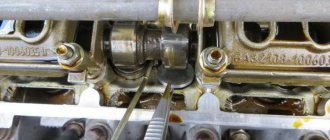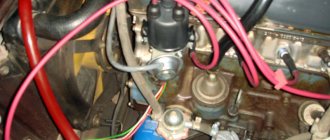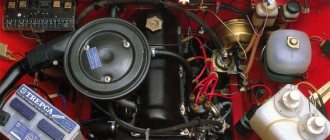01/25/2022 22 179 Ignition system
Author: Victor
The ignition system plays an important role in internal combustion engines. The timeliness and power of spark formation and high-quality combustion of the fuel-combustible mixture depend on the uninterrupted operation of the spark protection system. How to set up the correct ignition order of the GAZ-53, how the system itself works, what its main malfunctions are - this article says.
[Hide]
Design of the GAZ-53 ignition system
In order to repair and configure the SZ on the GAZ-53, you need to know how it works.
These trucks are equipped with a contactless protection system, which consists of the following components:
- power source – battery;
- switch;
- wires;
- additional relay;
- coil;
- breaker-distributor;
- current indicator;
- resistor element;
- ignition switch (switch).
Knowing the structure of the protection system, the connection diagram of the protection device and its other components, as well as the functions that each element performs, you can identify problems based on their symptoms and eliminate their cause. All components of the system can be divided into groups according to the tasks performed.
For normal operation of the internal combustion engine, the following conditions must be met:
- powerful spark;
- correspondence between the formation of a spark and the operation of the power unit;
- no missed spark formation.
The entire electronic ignition system consists of two circuits: primary and secondary.
The primary includes the following elements:
- Battery with multi-core cables of large cross-section;
- a switch that supplies power to the circuit;
- primary winding;
- breaker distributor located in the distributor;
- switching device that ensures stable operation;
- the resistance necessary for successful starting of the engine and unloading the short circuit, preventing its overheating.
The secondary circuit includes:
- distributor;
- wires for supplying high voltage current;
- candles.
When the primary circuit receives power, a magnetic field is generated in the breaker. The rotation of the distributor interrupts the current in this place, which leads to the disappearance of the magnetic field. At this moment, a signal appears on the secondary winding, which goes to the cylinders.
Photo gallery
1. Contact SZ diagram
2. Diagram of a contactless SZ GAZ-53 with a switch.
Successful sparking is ensured by stable operation of the motor and the appearance of sufficient voltage on the electrodes. The power of the spark is affected by the size of the gaps between the electrodes and the amount of incoming voltage.
With a weak spark or its absence, fuel consumption increases and engine power decreases.
Article: 130-3707080, additional articles: JM 53-3707080 U/E41, 130-3707060
Order code: 022539
- Buy with this product
- show more
Cable resistance
| Cable length, cm | 30 | 78 | 79 | 82 | 85 | 101 | 106 | 111 | 116 |
| Resistance, kOhm | 4,38 | 4,36 | 4,47 | 4,50 | 4,85 | 5,86 | 6,08 | 6,39 | 6,72 |
- Buy analogues
- Buses / LAZ / LAZ 695N1 drawing
- » href=»/catalog/laz-47/avtobusy-36/laz_695n-222/lektrooborudovanie-99/#part363851″>Spark plug assembly (front right, front left and rear right)Electrical equipment / Electrical equipment
- Trucks and trailers / UralAZ / URAL-3752 drawings
- » href=»/catalog/uralaz-13/gruzoviki_i_pricepy-33/ural_375-274/shema_zajiganiya_avtomobilya_ural_375d__ris__113_-166/#part546012″>Front right and rear left spark plug assembly Electrical equipment / Ignition circuit for the Ural-375D car (Fig. 113)
- » href=»/catalog/uralaz-13/gruzoviki_i_pricepy-33/ural_375-274/shema_zajiganiya_avtomobilya_ural_377__ris__114_-167/#part546050″>Front right and rear left spark plug assembly Electrical equipment / Ignition circuit for the Ural-377 car (Fig. 1 14)
- Trucks and trailers / KAZ / KAZ 6081 drawing
- » href=»/catalog/kaz-22/gruzoviki_i_pricepy-33/kaz_608-146/ustanovka_priborov_zajiganiya__zamok_zajiganiya-103/#part557673″>Front right spark plug assembly Electrical equipment / Installation of ignition devices, ignition switch
- Engines, gearboxes, injection pump / ZMZ / ZMZ-5234.101 drawing
- » href=»/catalog/zmz-120/dvigateli__kpp__tnvd-45/zmz_5234_10-801/lektrooborudovanie-22/#part2139452″>High voltage wiring harness right Electrical equipment / Electrical equipment
- Engines, gearboxes, injection pump / ZMZ / ZMZ-5234.10 (Euro 3)1 drawing
- » href=»/catalog/zmz-120/dvigateli__kpp__tnvd-45/zmz_5234_10__evro_3_-805/lektrooborudovanie-22/#part2140818″>High voltage wiring harness right Electrical equipment / Electrical equipment
There are no reviews for this product yet.
One of the most important parts of modern ignition systems is high-voltage wires. They are responsible for supplying an electrical impulse from the ignition coil to the spark plugs. This article is devoted to the structural features of this component, its most important characteristics and possible causes of failure.
Note! Photos are for illustrative purposes only and may differ from the actual product in stock. If you are interested in any specific characteristics (color, shape, size, compliance with the product in the warehouse, etc.), please clarify this information with the managers when agreeing on the order
.
You can buy “High-voltage wires GAZ-53, 66, PAZ** “G-part” (GAS) SILICONE (with tips) / 130-3707080-500 (130-14-3707080-500) / 28763″
online right now. To do this, simply add the item to your cart or use the “one-click order” option.
Possible malfunctions of the SZ: signs and causes
Malfunctions in the SZ affect the power of the power unit, it decreases, and economical fuel consumption.
The following reasons can be cited for the unstable operation of the SZ on the GAZ-53:
- Switch overheating or failure. When the switch overheats, the spark disappears and the engine will not start. It becomes possible to start the engine only after it has cooled down and a spark appears. The coil is also susceptible to overheating.
- Breakdown in high-voltage wires. This happens if the wire is not held tightly enough in the distributor cover: the motor will operate unstably and intermittently. The breakdown of the wires is noticeable in the dark - blue sparks jump.
- The cover on the breaker-distributor burned out. A malfunction can be detected by visual inspection. It is possible to burn in the place where the corner with the spring is installed. The cover must be free of defects and must not have potholes or cracks.
- The contacts of the distributor slider may burn out.
- Breakdown of candles.
If the diaphragm makes gaps on the vacuum regulator of the distributor, then a drop in engine power is observed. Moreover, if you accelerate sharply, the power unit will choke and may overheat. The distributor rarely fails; most often the cause of its failure is wear due to the exhausted resource.
Spare parts for trucks
Full model range: GAZ-3307, 53, GAZ-3309, GAZ-66, 3308, 33081, 33086, GAZ-33104
Ignition installation for GAZ-53, GAZ-3307 cars
The ignition system of GAZ-53, GAZ-3307 is a battery-based, contactless transistor with a voltage in the primary circuit of 12V, consists of electric current sources, an ignition coil, an additional resistor, a switch, an ignition distributor, spark plugs, spark plug tips, an ignition switch and low and low voltage wires. high voltage.
Fig.1. Diagram of the ignition system GAZ-53, GAZ-3307
A - to the starter; 1 - ignition coil; 2 - primary winding; 3 - secondary winding; 4 - battery; 5 - current indicator; 6 - additional starter relay; 7 - additional resistor; 8 — ignition and starter switch; 9 - noise suppression resistor; 10 — spark plug; 11 — distributor-sensor; 12 — interference suppression resistor of the slider; 13 — distributor winding; 14 - permanent magnet; 15 - switch; R1 - MLT-8.2 kOhm resistor; R2 - MLT-1 resistor, R3 - MLT resistor; R4 - MLT-82 kOhm resistor; R5 - MLT-62 Ohm resistor; R6 - MLT-200 Ohm resistor; R7, R8 - MLT-47kOhm resistors; C2 - capacitor K73-17-250V-0D; SZ - capacitor K73-17-4008-1; C4, C5—capacitors K73-17-250V-0.047 µF; C6 - capacitor K50-29-160V-10; C7 - capacitor KL-2-I20-500V-1000; VI - diodes KDYu2BiliKD4 521A; V2 - diodes KD209A or KD212A; V3 - transistor KT 848 A; V4, V5 - transistors KT630B or KT653B; V7 - diode 102B
Reliable and economical engine operation depends on the uninterrupted operation of the GAZ-53 ignition system. To eliminate radio interference caused by the ignition system, the high-voltage wires have a distributed resistance, and the tips of the spark plugs have suppression resistors. The ignition system diagram is shown in Fig. 1.
Technical characteristics of the ignition system of GAZ-53, GAZ-3307 cars
Ignition order of GAZ-53 - 1 - 5 - 4 - 2-6 - 3 -7 - 8 Type of ignition distributor (distributor) - 24.3706 Distributor shaft rotation speed per 1 minute with uninterrupted spark formation when working with a B116 ignition coil on a three-electrode spark gap with a spark gap of 7 mm, min-1 - 20 - 2300 Direction of rotation of the ignition distributor roller (distributor) GAZ-53 - clockwise Ignition coil GAZ-53 - B116 Spark plugs - A11 The spark gap in the spark plugs, mm - 0.8 — 0.95 Additional resistor — 14.3729 Switch — 13.3734 or 13.3734-01 Spark plug tip — 35.3707200 Tip resistance, kOhm — 4 — 7
The ignition coil GAZ-53, GAZ-3307 (B 116) is used to convert low voltage current into high voltage current.
The ignition coil GAZ-53, GAZ-3307 (B 116) is a transformer, on the iron core of which the secondary winding is wound, and on top of it is the primary winding. The core with windings is installed in a sealed steel case filled with oil and closed with a high-voltage plastic cover.
Winding resistance at a temperature of 15 - 35 ° C: primary 0.43 Ohm, secondary 13,000 - 13,400 Ohm.
Maintenance of ignition GAZ-53, GAZ-3307
To protect against possible breakdown of the plastic cover, the coil must be cleaned of dirt, dust and oil, and the high and low voltage wires must be checked for secure fastening.
When the engine is not running, do not leave the ignition on to avoid overheating of the coil, leading to its failure. The use of other types of ignition coils is unacceptable.
The causes of malfunction of the ignition coil of GAZ-53, GAZ-3307 can be: insulation breakdown; turn-to-turn short circuit; chips and cracks in the plastic cover; burnout of the cover and ignition coil due to the high-voltage wire not being sent to the socket.
Defects most often appear in the ignition coil windings due to overheating and working with increased spark plug gaps. Overheating occurs mainly when the ignition is on and the engine is not running.
Before removing the ignition coil of GAZ-53, GAZ-3307 for replacement, you should make sure that the wires are connected to the coil terminals in good condition and securely. The coil should be checked on a special stand together with a transistor switch, an additional resistor and a distributor.
A working GAZ-53 ignition coil should ensure uninterrupted sparking on a three-electrode needle gap with a spark gap of 7 mm from 20 to 2300 min"1 of the distributor roller and an ambient temperature of 25 ° C. If the coil does not meet these requirements, it should be replaced.
Ignition distributor (distributor) GAZ-53, GAZ-3307
The distributor of GAZ-53, GAZ-3307 (24.3706) cars (Fig. 2) is a generator that generates voltage pulses to control a transistor switch and to distribute high-voltage current pulses across the spark plugs.
The GAZ-53, GAZ-3307 distributor automatically adjusts the ignition timing depending on engine speed and load. Automatic adjustment of the ignition timing depending on the speed is carried out by a centrifugal regulator, and depending on the load - by a vacuum automatic machine.
Fig.2. Ignition distributor (distributor) GAZ-53, GAZ-3307
1 - body; 2 — oiler; 3 — weight of the centrifugal machine: 4 — spring of the vacuum machine; 5 — adjusting washer; 6 — vacuum machine; 7 - diaphragm; 8 — rotor magnetic circuit; 9 - permanent magnet of the rotor; 10 - rotor; 11 - cover; 12 — noise suppression resistor; 13 — central output; 14 - central contact resistor; 15 — slider; 16 - felt; 17 — half-screen; 18 - screw; 19 — stator winding; 20 - stator; 21 — magnetic circuit of the stator winding; 22—stator support; 23 - ball bearing; 24 — spring of the centrifugal machine; 25 — thrust ball bearing (a thrust washer is installed on part of the sensors); 26 — bushing; 27 - roller; 28 - octane corrector; 29 — thrust washer; 30 - pin; 31 — roller spike
In housing 1, a roller 27 is installed in two bushings 26. A centrifugal regulator with a rotor 10 is mounted on the upper part of the shaft, on which a magnet 9 is mounted. A slider 15 is installed on the upper part of the rotor. The housing contains a stator 20, which is attached to a support 22 with a bearing 23 .
The top of the housing is closed with a cover 11, which contains terminals for high-voltage wires from the spark plugs and ignition coil. Shaft 27 of the ignition distributor of GAZ-53, GAZ-3307 is driven into rotation by the camshaft gear.
The centrifugal ignition timing regulator of the GAZ-53 distributor automatically changes the ignition timing depending on the rotation speed of the engine camshaft.
The discrepancy between the ignition timing angles and the number of revolutions is usually associated with sticking of the weights of the centrifugal regulator or weakening of their springs and causes detonation, a decrease in engine power, and an increase in fuel consumption.
Instructions for setting up the ignition
The cause of engine overheating and loss of power may be late ignition. This may manifest itself as popping noises in the intake manifold. Therefore, you need to know how to install the ignition correctly (the author of the video is Nail Poroshin).
Installation is carried out according to the marks as follows:
- First, you need to set the piston on the first cylinder to TDC and align the installation indicator mark with the mark on the crankshaft pulley.
- Next, the crankshaft must be turned counterclockwise until the marks 9 on the pointer coincide with the marks on its pulley.
- Then you need to loosen the bolt on the top plate of the corrector, thanks to which it is attached to the breaker.
- Next, you need to connect one control wire to the car body (ground) and the second to the breaker terminal. After turning on the ignition, the breaker should be turned slowly until the control lights up. This indicates that the contacts have begun to open.
- Now you need to tighten the breaker mounting bolt and install the cover and rotor. In the area opposite to the one where the rotor plate was installed, you need to connect the high-voltage wire to the spark plug on the 1st cylinder. The remaining wires are connected to the cylinder spark plugs, according to the order in which they work: 1-5-4-2-6-3-7-8.
It is necessary to set the ignition timing of the GAZ-53 accurately, since with deviations the engine power decreases and fuel consumption increases. In addition, burnout of valves, pistons, breakdowns in the cylinder head gasket and other problems associated with detonation are possible.
Therefore, the final adjustment is performed with the engine running, which warms up to a coolant temperature in the range of 80 - 90 degrees. With the engine running at idle speed, you need to loosen the fasteners of the distributor with a 10mm wrench so that it can be turned. After slightly turning the distributor counterclockwise, tighten the fastening bolt.
Pressing on the gas is how the power unit works. If you hear a “ringing of fingers,” that is, detonation occurs, turn the distributor clockwise in the opposite direction. Through trial and error we set the desired advance angle.
The test is done on a moving vehicle. With stable operation of the power unit, tuning is no longer needed.
Sometimes the distributor is pushed to the extreme position, but the adjustment is not enough. In this case, you need to check the position of the distributor drive relative to the engine.
A check is performed with the engine not running:
- First, marks are placed on the front crankshaft pulley. They must match on the 1st and 6th cylinders. To avoid making a mistake, it is better to remove the valve covers from the first 4 cylinders and check the valves. If the valve marks are in the correct position, the valves in the 1st cylinder will be free.
- Having removed the distributor, we inspect how the drive is installed. If it is located parallel to the motor, then it needs to be replaced or repaired; adjustment, in this case, will not help.
- If the position of the drive is incorrect, you need to unscrew the fastening nut and remove the part.
- After the drive is completely installed in its place, you need to check that the groove for the distributor runs parallel to the internal combustion engine (in the direction of travel of the car), and a small section of the bushing on the distributor faces the 4th and 8th cylinders (towards the driver) . By experience, you need to achieve the correct position of the distributor drive.
Self-adjustment
If the ignition is late, the problem can be solved on your own. To adjust the distributor drive, it is necessary to correctly install and set the marks.
The drive is installed as follows:
- First, set the piston of the first cylinder to top dead center. The crankshaft is rotated until the marks on its pulley are aligned with the mark of the top point.
- Afterwards, the crankshaft is rotated until the marks on the pulley are aligned with mark 9 on the pointer.
- Next, you should loosen the screw securing the upper plate of the corrector to the breaker. It is necessary to connect the test lamp to the breaker terminal and ground. The ignition is activated, after which the breaker body is turned counterclockwise until the lamp starts to burn
- Next, you need to tighten the breaker fixing screw and install the rotor with the cover. At the rotor plate section, a wire is connected to the spark plug of the first cylinder. All other cables must be connected to the spark plugs in a clockwise direction, while respecting the order of operation of the cylinders themselves. That is, first, fifth, fourth, second, sixth, third, seventh and eighth. When setting the ignition correctly, you should turn the crankshaft so that the mark on its shaft does not reach the central mark on the TDC indicator itself (video author - Nail Poroshin).
It often happens that even after adjusting the electronic SZ, the motor still overheats. The power unit loses traction, gasoline consumption begins to increase, and interruptions in engine operation may occur.
The problem can be solved by adjusting the angle of the system when the internal combustion engine is running:
- When the power unit is idling, you need to get to the distributor fixing screw. Use a 10mm wrench to loosen it.
- Then turn the distributor slightly in a counterclockwise direction. The screw should be secured.
- While pressing the gas pedal, check the throttle response of the power unit. If you hear that the power unit has begun to detonate, that is, a ringing sound has appeared, move the distributor back. As a practical matter, you need to set the required angle.
- After this, the operation of the power unit must be checked while driving. If the motor begins to operate normally, we can assume that the adjustment process has been successfully completed.
The old-fashioned way of “revitalizing” a contact
That's usually how it goes. Yesterday the car was fine, it started the first time. In the morning - like “dead”. Any motorist who understands cars will remove the spark plugs, inspect and check them first. No spark.
Further checking is carried out on the coil. It is necessary to inspect the main armored wire to see if current flows through it. No spark again?
Here's what to do:
- Check if current is flowing to the bobbin (coil).
- Check if voltage is going to the switch.
If there is voltage, but the spark does not go through the armored wire, the first doubt falls immediately on the woman. She is removed, checked thoroughly, and called. Is she working? It would seem like an opportunity? But this happens often. Don't panic.
And here the distributor itself, the distributor, comes to the fore. It is dismantled, the hall sensor is removed, cleaned of oil (sometimes it gets inside).
As a rule, these actions are enough for a spark to reappear on cars with a non-contact ignition system (non-contact ignition system), where the distributor becomes the “culprit” for the voltage loss. And the reason that the spark has disappeared is either oil getting into the sensor or a loose contact.
This often happens: the wires/communications connecting the switch and distributor provide unreliable, weakened contact. The old “old-fashioned” method of touching everything with your hands is 100 percent effective here. In this way, you can “reanimate”, “revive” the contact.
This method will help you save on the purchase of a coil, hall sensor or switch. It is not uncommon for amateurs in car service centers, who have little understanding of the matter, to send the car owner to the store for parts that are actually in full working order.
Electrical diagram
First of all, we note that any electrical circuit of a car, including one like the GAZ 53, is equipped with the following elements:
- GPT – alternating current generator;
- KTS – contact-transistor ignition system;
- start heater;
- wiring of different voltages connecting all elements into a single circuit.
Attention. The electrical circuit of the GAZ-53 truck is not designed for non-standard loads. Therefore, it is forbidden to start the engine if the cable running from the generator to the regulator is damaged or if it “sparks”.
Ignition system
Let's first consider the ignition system. It is known that it is battery operated, with a circuit voltage of 12 V.
It also consists of the following components:
- switch;
- sources supplying current;
- coils;
- resistor (additional);
- ignition distributor (distributor);
- candles with their tips;
- ignition switch;
- wiring.
Note that the smooth operation of the engine directly depends on the normal functioning of the ignition system. To avoid radio interference caused by the ignition system, the wires are equipped with a resistance distributor (this mainly applies to HV wires), and the tips of the spark plugs are equipped with suppression resistors. (See also the article Features of the GAZ wiring diagram.)
Let us now consider each element of the ignition system separately and find out how it functions.
- Spark plugs for GAZ 53 must have a factory gap of 0.85 mm. They must have a nichrome electrode - A11, A11-1, A10-H and others are suitable. The ignition order can be seen in the photo below.
- The ignition distributor is used in this car so that the rotation speed of its roller is one minute with uninterrupted sparking. Functions simultaneously with the ignition coil. The roller must rotate clockwise.
- Ignition coil - B114-B or B116 (more advanced). Generates high voltage pulses in the ignition system of a GAZ 53 car. It has a rated voltage of 12V and a secondary voltage of 17kV.
- The ignition switch amplifies the signal from the distributor sensor and the ignition coil. (See also the article Gazelle wiring diagram: how to install it yourself.)
Note. To connect all of the above parts and assemblies of the vehicle's electrical equipment into a single circuit, low voltage wires are used. They must be protected with polyvinyl chloride insulation.
Wiring
The basic rules that are followed when working with wiring are as follows.
- Careful attention is always paid to the wiring of the GAZ 53, which may be subject to various influences. If the insulation of any wire is broken, its metal component may touch the car body, thereby causing a short circuit. There is no need to say what this leads to (burning of insulation, fire, etc.).
- It is important to take into account the fact that the wires, no matter how well they are insulated, are always subject to mechanical stress during vehicle operation. In particular, it is possible for the wiring to rub against sharp edges of car parts, excessive sagging, etc.
- In addition, special attention should be paid to the cleanliness and tightness of connecting the wires to the terminals. Care must be taken to ensure that mixtures such as gasoline or oil, which can destroy the insulation and shorten the service life of the wires, do not come into contact with the surface of the wires.
- It is imperative to check the serviceability of the jumpers located between the engine, frame and cab of the GAZ 53.
What is ASZ
ATTENTION! A completely simple way to reduce fuel consumption has been found! Don't believe me? An auto mechanic with 15 years of experience also didn’t believe it until he tried it. And now he saves 35,000 rubles a year on gasoline! Read more"
There may be several reasons for the lack of sparking. Most often, the culprit is the distributor with its elements. But no less well-known reasons are: a bad battery, the armored wires themselves, the ignition coil or its winding.
As you know, the car ignition system or ASZ is designed to effectively ignite fuel. It is clear that without a spark there can be no talk of any ignition. It is not for nothing that the ASZ of a gasoline engine is also commonly called a spark ignition system.
Depending on the type of process control, there are several gas stations. On domestic classics, for example, a contact ASZ is used, and on foreign cars - transistor or electronic.
The distributor in the contact ASZ plays the role of a current and energy distributor across the cylinders. At the same time, it acts as a current energy storage device.
A woman is also considered to be a current storage device.
If in a contact ASZ accumulation and distribution are carried out in a single mechanism (distributor), then in a BASS (transistor system) a switch is responsible for accumulation, clearly interacting with the Hall sensor. As for the distribution of energy, it is still controlled by the distributor.
It is noteworthy, but in most cases the spark disappears at the most inopportune moment. For example, if you urgently need to go somewhere in your car.











